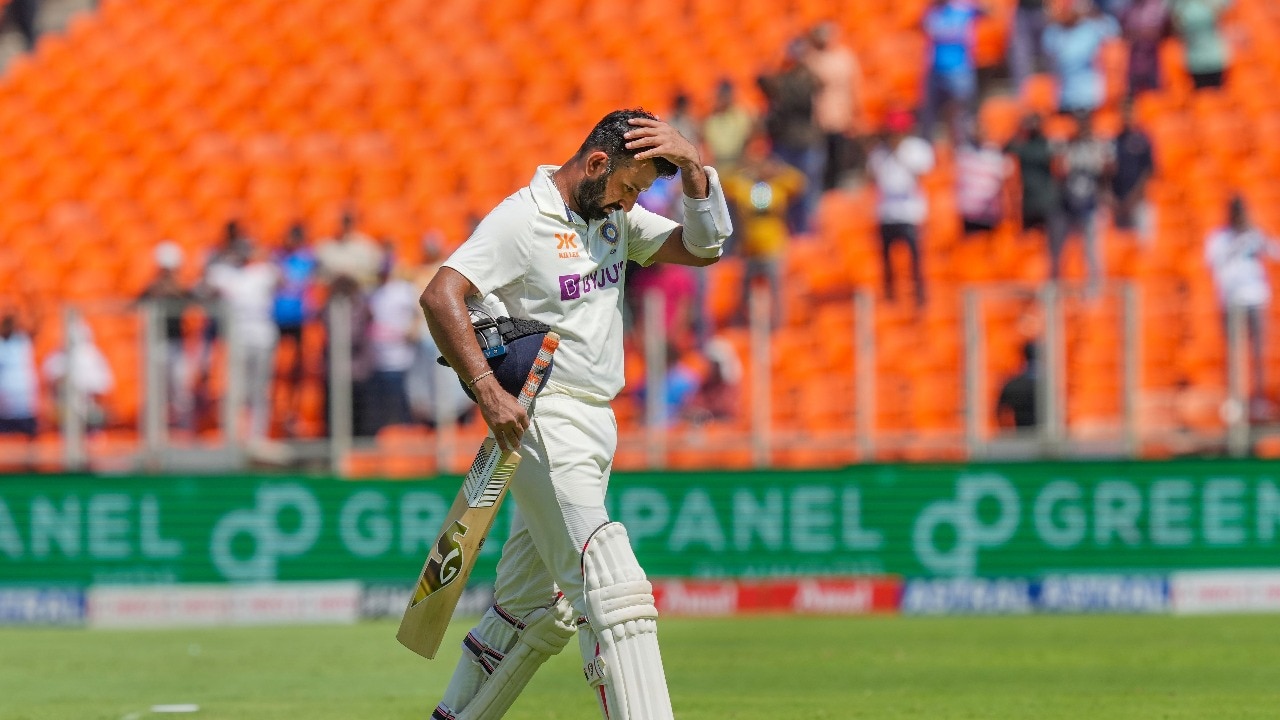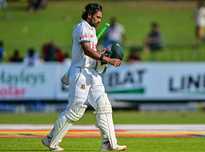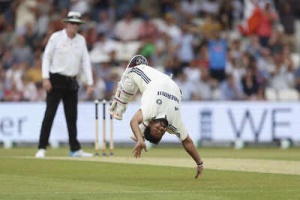
Some exits in sports come with fanfare, with grand send-offs, emotional speeches, and floodlit tributes played out before adoring crowds. And then there are farewells like that of Cheteshwar Pujara's - unassuming, unembellished, and quietly dignified.
In keeping with the man himself, there was no extravagant gesture, no lap of honour. Just a thoughtful note posted online, in the same understated voice with which he lived his cricketing life. And with that, an era drew to a close.
Watching Pujara bat was almost like listening to a classical composition. He began with quiet restraint, building slowly, his strike rate gathering rhythm over time. Each innings had the measured patience of a raga finding its flow-subtle at first, then swelling into something powerful and absorbing.
In many ways, Pujara was the last echo of a fading tradition, a Test cricketer of the old world who persisted into a landscape defined by instant gratification, big hits, and shrinking patience. If Test cricket is a symphony, Pujara was its classical violinist - sensitive, nuanced, disciplined. And while others around him turned up the volume, he continued to play in a key that required listening closely to appreciate.
His retirement marks not merely the end of a career, but the silencing of a certain way of playing and being in cricket. A way that placed craft over charisma, substance over sparkle, and resilience over razzmatazz.
Born in Rajkot in Gujarat, Cheteshwar Arvind Pujara grew up in a household that revered cricket, not celebrity. His father, Arvind Pujara, a first-class cricketer himself, became his first coach and mentor. Under the shade of a neem tree at Kothi Ground, a young Pujara faced thousands of deliveries every day, his technique chiselled in silence, his temperament toughened by repetition.
There were no shortcuts, no gimmicks. His early years were shaped not by flair but by fortitude. He was never destined to be a poster boy; his destiny was to be a pillar.
As he grew, his cricketing identity only became more resolute. The world sprinted towards T20s and franchise leagues; Pujara stayed with the format that demands the most but gives back the most deeply - Test cricket. He wasn't chasing relevance. He was safeguarding tradition.
For more than a decade, Pujara was India’s designated fire - breaker at number three - a role once occupied by Rahul Dravid, whose absence left a chasm as wide as it was deep. Pujara never sought to imitate Dravid. Instead, he honoured the ethos that Dravid embodied: selflessness, application, and the supreme value of occupying the crease.
His numbers tell one part of the tale:
But the essence of Pujara’s contribution lies in what numbers cannot capture: the sheer weight of his time at the crease, the slow, deliberate building of pressure in India’s favour, the erosion of opposition resolve through attrition. Between 2010 and 2023, he faced more than 16 percent of all deliveries India encountered in Test cricket - a statistic that speaks volumes about both his value and his virtue.
If these numbers made him indispensable, it was in Australia where his grit elevated him into legend.
In an era lit up by Tendulkar, Sehwag and Kohli’s dazzling strokeplay, Pujara, much like Dravid, stood out for his defence, temperament and grace. Bowlers valued his wicket the most - a true tribute to a competitor who proved that aggression lies in resilience, not in words or gestures.
There are few modern Test series as iconic as India’s twin triumphs in Australia in 2018-19 and 2020-21. And in both, the quiet man from Saurashtra was the fulcrum.
In the 2018-19 series, Pujara scored 521 runs, faced 1,258 deliveries, and notched up three centuries. At a time when Australian quicks were hurling fire and fury, Pujara was the sponge—absorbing it all, session after session. His innings weren’t thrilling; they were theological. He defended not just his wicket, but the sanctity of Test cricket itself.
And then came 2020-21 - a series that felt more like a tale from mythology than from sport. With India ravaged by injuries, confidence shaken, and pride bruised after the infamous 36 all out in Adelaide, Pujara became their spiritual centre. He didn't dazzle; he endured. In the final Test at the Gabba, where India pulled off a historic chase to win the series, Pujara took 11 blows to the body.
He didn't flinch. He didn't blink. He batted on, absorbing punishment with the quiet resolve of a soldier in trench warfare.
His body bore the bruises, but his presence kept India's dream alive.
And fittingly, it was Pujara's stubborn resistance that carried Kohli (Ajinkya Rahane) and Shastri into history as the first Indian captain-coach duo to win a series in Australia twice.
Pujara didn’t just play Test cricket. He lived it. He respected it.
He played for moments like Bengaluru 2017 - when his 92 in a low-scoring thriller turned the match India’s way. Or Ranchi that same year, where he compiled a marathon 202, lasting 525 deliveries, the longest innings ever by an Indian in Tests. Or Southampton 2018 - when his unbeaten hundred single-handedly gave India a fighting chance.
He wasn't the man you looked to for fireworks. He was the one you leaned on when the lights began to flicker.
In many ways, he was the personification of what makes the format timeless: perseverance, pressure, patience. The ability to suffer in silence, and then emerge - maybe not victorious, but undefeated.
In an age where flamboyance fetches fame and acceleration defines ability, Pujara remained almost anachronistic. He rarely hit sixes. His cover drives were technically sound, but not dripping with flourish. He didn't strut. He simply stood. And batted. And batted some more.
He didn’t chase the moment; he became the moment.
Watching Pujara bat was a lesson in restraint. A flicker of the wrist here, a well-judged leave there, and an unerring sense of what to play and what to let go. He viewed attack not as a default but as a privilege - earned after hours of toil. In a game increasingly dictated by strike rates and highlight packages, he was the outlier who reminded us that survival, too, is an art form.
Even when critics circled, calling for more aggression, Pujara stayed rooted in his method. “It is easy to play shots,” he once said. “When you start playing shots, it means you are under pressure. When you defend confidently, you are on top of the bowler.”
And he practised what he preached. Tirelessly.
Behind the grim-faced warrior on the field was a gentle, humble man. Pujara never courted controversy. He didn't sledge, didn't make bold predictions, and never indulged in dramatic celebrations. His temperament was monk-like, his presence calming.
Inside the dressing room, he was a leader in his own way, but his quiet nature meant he was never celebrated enough. True to character, Pujara won't complain. He will rest content, knowing he gave his all and that history will remember him as a warrior with the heart of a gentleman.
He had no interest in glamour. No off-field persona to inflate. No brand to manage. His only currency was trust. And over the years, his captains knew that when the chips were down, they could bank on him to stay at the crease-even if the scoreboard barely moved.
That loyalty-earned, never demanded-was what made him beloved in the dressing room.
And so, true to his nature off the field, his farewell was as modest as his life between the stumps. But for those who watched him, and for those who played alongside him, the silence he leaves behind will speak louder than any celebration ever could.
In a time when Test cricket continues to fight for space amidst shorter formats, Cheteshwar Pujara stood as its most faithful disciple. A classical musician in a rock concert. A book in a world of reels. A candle in the face of floodlights.
We may not see another quite like him.
And perhaps we don’t need to. Because, like all timeless art, he wasn’t meant to be replicated—just remembered.
So, let us not mourn his retirement. Let us celebrate the beauty he brought to a game that often forgets its roots.
In the end, if cricket is a mirror to character, then Cheteshwar Pujara showed us the virtues of stillness, patience, humility - and the unshakeable belief that some things are worth holding on to.
And now, as he walks away from the game, there are no grand gestures. No choreographed send-off. It is fitting, really. For a man who never sought the spotlight, the quiet withdrawal from the game he loved feels almost poetic.
But make no mistake - his legacy will not fade.
He may not feature in the franchise draft. He may not be on billboards. But in the minds of true cricket lovers, he will remain eternal. Every time a young batter chooses to block instead of bash, every time a team survives a session they had no right to, every time a match is saved rather than won, Pujara’s spirit will be there.
Even when the world moves on.
Some exits in sports roar with applause and ceremony. Not with Pujara, though. His was a whisper, a bow, a note left behind. And in that silence lies a permanence that noise can never achieve.
And when the music finally stopped, what lingered was not the noise, but the silence he had so patiently filled with meaning.
Newer articles
Older articles
 Greg Chappell: Rishabh Pant is Revolutionizing Cricket with Unorthodox Style
Greg Chappell: Rishabh Pant is Revolutionizing Cricket with Unorthodox Style
 Earth's Mantle Unleashes Volcanic Fury, Carving New Ocean in Africa
Earth's Mantle Unleashes Volcanic Fury, Carving New Ocean in Africa
 Najmul Hossain Resigns as Bangladesh Test Captain After Sri Lanka Defeat
Najmul Hossain Resigns as Bangladesh Test Captain After Sri Lanka Defeat
 Smith Targets Test Return After Baseball Cage Rehab in New York
Smith Targets Test Return After Baseball Cage Rehab in New York
 Oral Cancer: Spotting the Signs, Understanding the Risks, and Why Early Detection is Key
Oral Cancer: Spotting the Signs, Understanding the Risks, and Why Early Detection is Key
 Is Daily Bowel Movement Necessary? When Irregularity Signals a Health Issue
Is Daily Bowel Movement Necessary? When Irregularity Signals a Health Issue
 Shimron Hetmyer's Last-Gasp Six Stuns MI New York, Seals Record MLC Chase for Seattle Orcas
Shimron Hetmyer's Last-Gasp Six Stuns MI New York, Seals Record MLC Chase for Seattle Orcas
 Rishabh Pant's Somersault Celebration Draws "Unnecessary" Remark From Doctor Who Aided Recovery
Rishabh Pant's Somersault Celebration Draws "Unnecessary" Remark From Doctor Who Aided Recovery
 India's First Dengue Vaccine Nears Finish Line: Phase 3 Trials Show Promise
India's First Dengue Vaccine Nears Finish Line: Phase 3 Trials Show Promise
 Asia Cup 2025: ACC Reportedly Targets September Start Amid Rising Hopes, Aims for Schedule Release Next Month
Asia Cup 2025: ACC Reportedly Targets September Start Amid Rising Hopes, Aims for Schedule Release Next Month